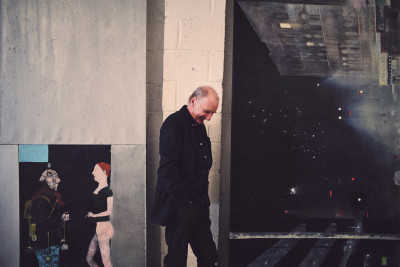Living colour
Living colour
By Fiona Maddocks
Published 3 March 2014
We visit the converted stable where the nonagenarian artist Alan Davie RA creates his jewel-like paintings.
-
From the Spring 2014 issue of RA Magazine, issued quarterly to Friends of the RA.
Alan Davie delights in paradox. At 93, he is one of the oldest and newest members of the RA, a fact that charms him no end. ‘It’s quite a farce isn’t it,’ he says, a twinkle in his eye suggesting it is the kind of farce he rather enjoys. ‘I was always very anti-academic and now I find myself one of them.’ He was elected a Senior Academician in 2012. To become an RA at an age when he appreciates it, instead of in mid-youth when he might have been dismissive, chimes with Davie’s spontaneous, rule-breaking outlook on life.
His Hertfordshire studio, lit only by skylights, is an unadorned, white rectangular space opening straight from his house. In a tiny hamlet 20 miles from London, the Davie domain feels like country, but big roads run close by. He and his wife Bili arrived there ‘about 60 years ago’ and made the old stables their own, living together happily until she died a few years ago.
The house itself, tucked behind a hedge and hard to see, appears to be a small, unexciting post-war brick box until you walk inside. Colour hits you from every direction: walls painted all shades of red, from bright tomato to deep crimson, terracotta to scarlet. In the open-plan design, one room leads to another, a purple chair here, a green one there – one of several original Arne Jacobsen Egg chairs Davie bought when they were first designed in 1958. An acid-yellow shaggy carpet runs the length of one room, brightening the grim, wet afternoon. ‘Gold,’ he corrects gently.
-

Alan Davie RA
Photo: Eamonn McCabe
-
Davie is in a quiet mood when we meet, recuperating from a recent stay in hospital. He looks magnificent: long, silken hair and beard framing his strong, sharp features; dressed in a deliberate craze of colour, like one of his orgiastic, abstract paintings, with fuchsia-pink pullover, mustard coloured sports shirt, green jacket and grey cord trousers. If you had to construct a prototype artist from a kit, he might reasonably end up looking like Davie.
The Scottish painter was born in Grangemouth, ‘a rather miserable place’, in 1920, the son of an artist father and pianist mother. Art and music, therefore, were twin ingredients of his childhood, but he opted to study painting at Edinburgh College of Art from 1938-40 until war interrupted. After the army, he travelled through France, Italy and Spain with Bili during the late 1940s. These were formative years, when he met Jackson Pollock, Robert Motherwell, Mark Rothko and others, won the support of collector Peggy Guggenheim and had his first London show at Gimpel Fils – still his gallery – in 1950.
In the six-and-a-half decades since, he has developed his fluid, playful, improvisatory style on canvas as well as in life. Here is a man who played jazz professionally – sax and piano alongside John Dankworth and Ronnie Scott – while being a busy artist. He could have been a champion golfer ‘if nerves hadn’t got the better of me’ but decided he preferred the riskier sport of gliding. ‘Now that’s scary, flying above the cliffs at Land’s End.’
Early in his career he made jewellery and other metal objects: chunky rings and elegant brooches, as well as silver spoons that once sold at Harrods. He retrieves a selection of various objects from a drawer. ‘And look at this nice phallic one,’ he chuckles, pulling out a bulbous pendant in heavy silver which is, yes, phallic. Alongside all this, composing music and writing poetry have been, and remain, mainstays of his prolific existence.
The studio itself contains, essentially, only the oil paint and stubby brushes he uses to paint, together with dozens of canvases stacked against walls and some of his latest sketches – he may do up to 20 a day – on the floor. An accretion of old paint, resembling an ancient sea wall, sits in the middle. Nothing here distracts him from work. The rest of the house, however, is crammed: Ashanti fertility dolls, Balinese shadow puppets, a prehistoric Mexican god figure, a brightly painted totem pole from Papua New Guinea. ‘I’m not a collector. I just acquire things I like.’
Quiet though Davie is, his hands are never still. He drums his fingers on the desk, then strums the tines of a comb buried in his pocket. Does he have a secret to longevity? Maybe, he suggests tentatively, not smoking, not drinking, never eating between meals, consuming honey and spending five minutes a day on an old exercise bicycle in his studio. Does he want to reach his century? ‘I hope so… I’ve got lots to do.’
BP Spotlights: Alan Davie is at Tate Britain, London from 14 April – 5 October 2014.
Alan Davie: Early Paintings is at Alan Wheatley Art, London from 9 April – 23 May 2014.
Alan Davie: Recent Works on Paper is at Gimpel Fils, London from 24 April – 23 May 2014.




